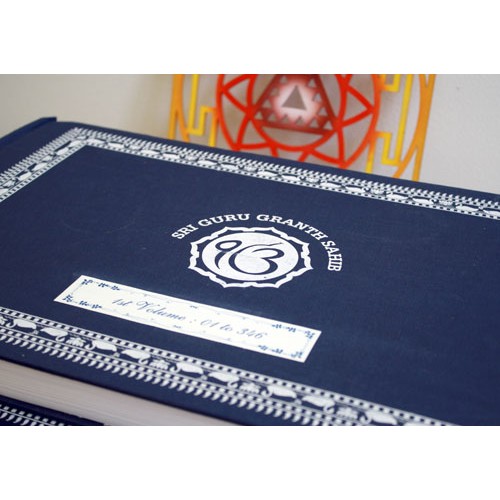Siri Guru Granth Sahib, Deluxe 4 Volume-Set
Gurmukhi / Roman Transliteration / English
This deluxe edition of the Siri Guru Granth Sahib contains beside the original Gurmukhi Text and the roman transliteration a very good english translation, especially for those who are not proficient in Gurmukhi or Punjabi. Each page conforms to the precise number of words found on each page of the original holy book. Each page has three columns; the first column has the original Gurmukhi text; the second column has the Roman transliteration; and the third column has an English translation of the original scripture.
Info about the Siri Guru Granth Sahib - the Holy Scripture of the Sikhs:
The poetry of the Guru Granth is in itself a subject worthy of the highest consideration. The language principally employed is the language of the saints evolved during the medieval period-a language which, allowing for variations, still enjoyed wide currency in Northern India. Its appeal lay in its directness, energy and resilience. Based upon some of the local dialects, it was leavened with expressions from Sanskrit, Prakrit, Persian and Arabic.
Another outstanding feature of the Guru Granth Sahib is the precision of its prosody. While a great deal of it, cast in traditional verse forms (salokas and pauris), could best be understood in the context of the well-known classical ragas, its hymns and songs make use of popular folk meters such as alahanis, ghoris, chands etc. The integral relationship between music and verse has been maintained with scholarly rectitude and concern. This complete musicalisation of thought in a scientific and studied manner makes for the unusually rigorous, yet supple, discipline of the Granth’s metrics and notations.
The entire Bani whose printed version in its current format comes to 1430 pages is divided into 33 sections. While the first section comprises the soulful and inspiring song of the Japji composed by Guru Nanak as also a few selected pauris or couplets, the final section is collection of assorted verses including the shalokas and the swayyas of the bhattas. The remaining 31 sections are named after the well-known classical ragas such as sri, magh, gauri, gujri, devghandhari, dhanassari, bilawal, kedara, malhar, kalyan etc. The division, thus, is strictly based on Indian musicology.
Furthermore, each psalm or song is preceded by a number (mohalla) which denotes the name of the composer-Guru from Guru Nanak onwards. It may be noted that the apostolic succession extends from the First to the Tenth Guru, and that the Gurus are often referred to reverentially by their place in the order.
What is more, each Guru speaks in the name of the Founder Guru whose spirit permeates his successors. The House of Nanak is indeed a spiritual decagon based upon a complete, inviolate geometry of vision. The major hymns-Japji (Guru Nanak), Anand (Guru Amar Das), Sukhmani (Guru Arjan Dev), Rehras (Guru Nanak, Guru Ram Das, Guru Arjan Dev) are widely recited solo and in congregation by the faithful as morning and evening prayers. Their soothing and ambrosial airs have brought solace and cheer to countless people all over the world.
Complete Siri Guru Granth Sahib, Deluxe edition, 4 volumes-set.

